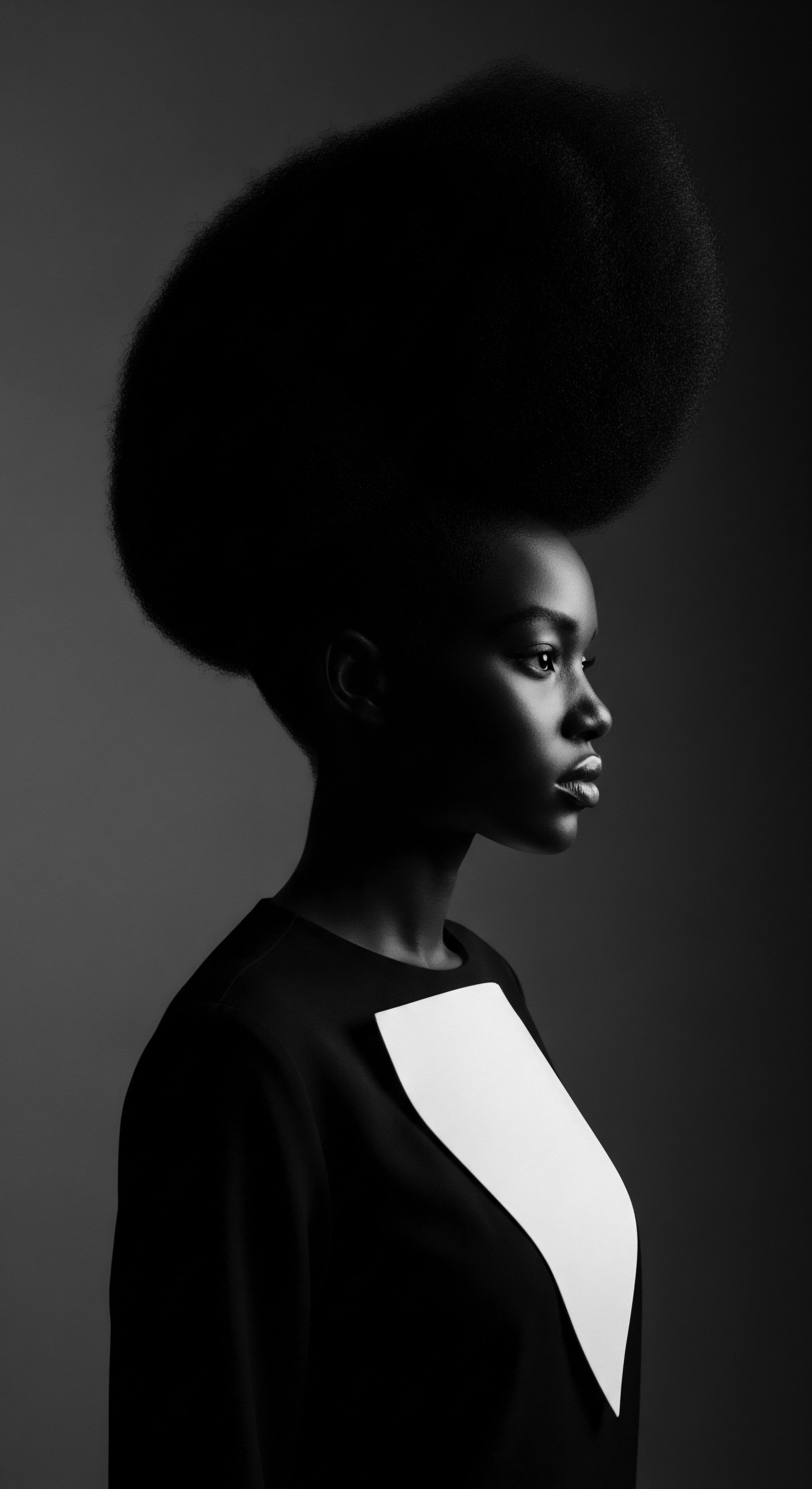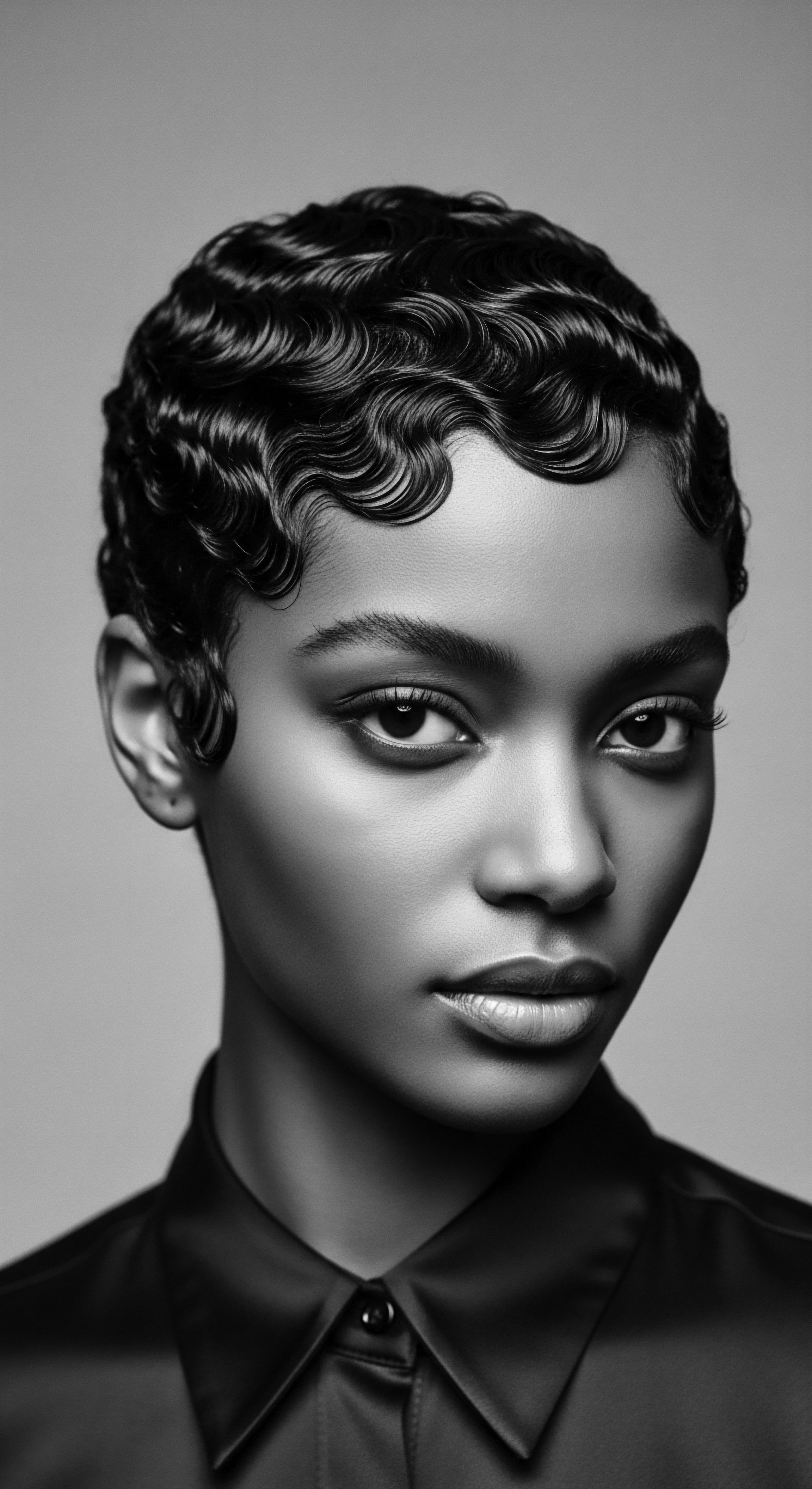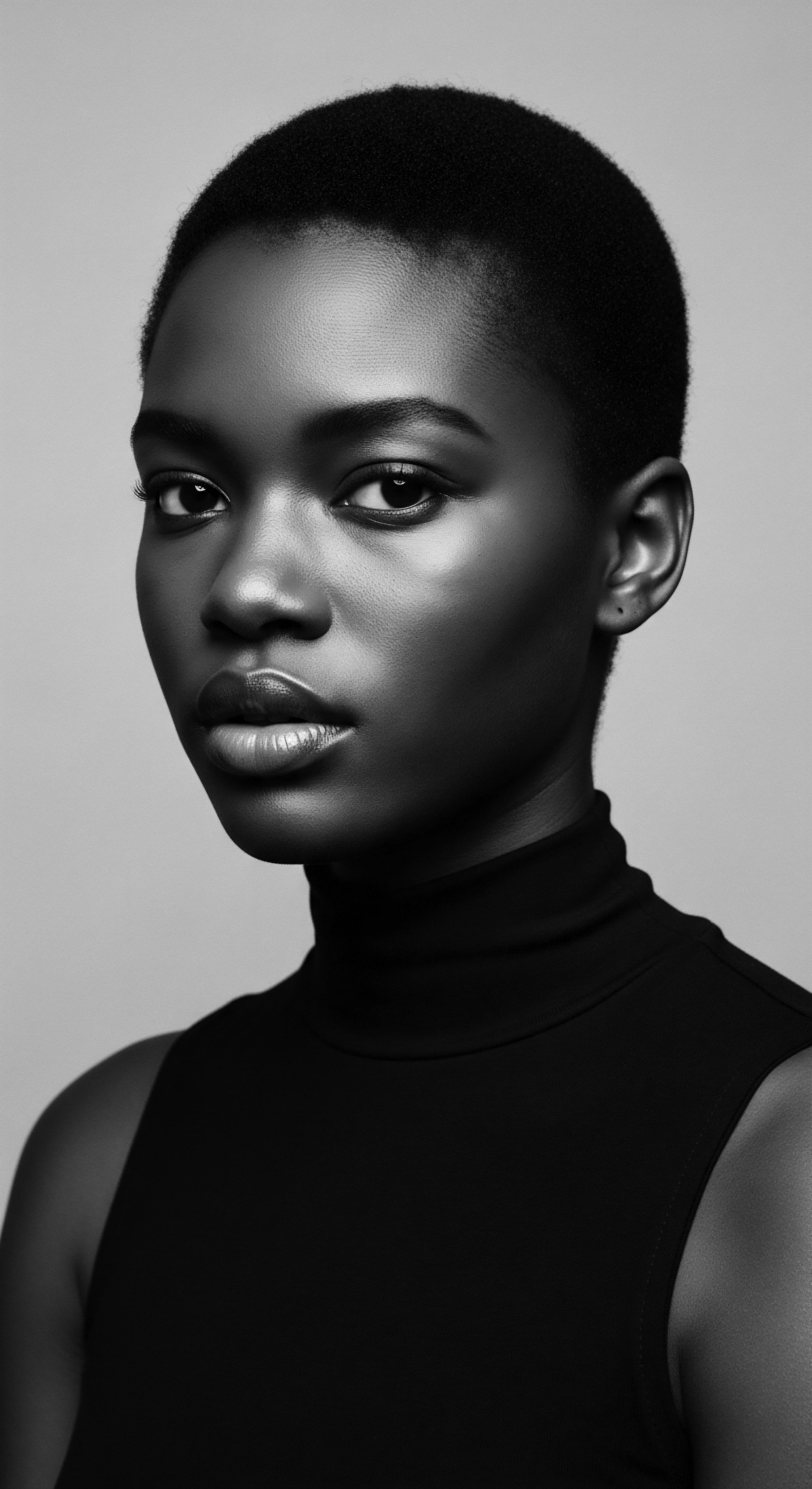
Roots
To journey into the ancestral currents that sculpted Black hair, one must first feel the silent whispers of the strand itself. It is a profound meditation, really, on what generations before us poured into its care, a testament to resilience, ingenuity, and an unwavering spirit. For those with coils and curls, the understanding of our hair’s story is not a mere academic exercise.
Instead, it is a homecoming, an affirmation of a living heritage flowing through every twist and turn of our hair. We seek to understand the very elemental biology, the ancient wisdom, and the enduring practices that laid the groundwork for how Black hair has been tended across continents and centuries.
The journey begins with the very structure of the hair, a marvel of natural architecture. Textured hair, particularly the tightly coiled varieties, presents unique characteristics stemming from its follicular shape and growth pattern. Unlike straight or wavy strands that emerge from more circular follicles, highly textured hair springs from elliptical or flat follicles, causing the strand to grow in a spiral or helical pattern. This unique morphology translates into inherent traits ❉ a propensity for dryness due to the difficulty of natural sebum traveling down the coiled shaft, and a tendency toward fragility at the points where the coil bends most acutely.
These biological realities have always informed care, long before scientific microscopes unveiled follicular secrets. The care practices that arose were not arbitrary; they were direct responses to the hair’s inherent needs, passed down through the ages.

Follicular Genesis and Ancestral Wisdom
The very genesis of a hair strand within its follicle tells a story centuries old, a narrative of adaptation and survival. Ancestral communities, lacking modern scientific apparatus, possessed an intuitive grasp of what nourished and protected their hair. They understood the hair’s need for moisture, for gentle manipulation, and for shielding from harsh elements. This understanding translated into practices that minimized breakage and promoted scalp health.
The fundamental nature of textured hair’s structure dictated its ancestral care.
Consider the Lipid Content within the hair shaft and on the scalp. Historically, communities relied on natural oils and butters – shea butter, palm oil, cocoa butter – not just for shine, but as a protective barrier against moisture loss, a recognition of the hair’s inherent dryness. These were not luxury items but staple elements of daily grooming, deeply intertwined with communal life and well-being. The very act of applying these emollients was a ritual, a moment of connection to the self and to the wisdom of generations.

Hair’s Blueprint Acknowledged
The nomenclature of textured hair, as we comprehend it today, with its classifications of curl patterns, porosity levels, and density, represents a modern attempt to categorize what ancestral practitioners understood through tactile experience and observation. While the scientific language is new, the insights often echo age-old understandings of how specific hair types respond to particular treatments. The concept of “porosity,” for instance, which describes the hair’s ability to absorb and retain moisture, finds its ancient parallel in the selection of conditioning agents. Hair that seemed to “drink up” moisture was treated with richer, heavier butters, while hair that felt sealed was perhaps prepped with lighter infusions.
The hair growth cycle—anagen (growth), catagen (transition), telogen (rest), and exogen (shedding)—was likely observed in its natural rhythms, influencing practices like seasonal protective styling or periods of minimal manipulation. While not articulated in scientific terms, the respect for the hair’s natural cycles was embedded in the care routines. For instance, prolonged protective styles during certain periods might have implicitly recognized the need to preserve length during anagen phases.
| Hair Characteristic Tendency for dryness |
| Ancestral Observation (Pre-Scientific) Hair felt "thirsty," absorbed oils readily, became brittle quickly. |
| Modern Scientific Term/Understanding Low sebum travel due to coil structure; higher evaporation rate. |
| Hair Characteristic Fragility at bends |
| Ancestral Observation (Pre-Scientific) Hair broke easily when roughly handled or dry. |
| Modern Scientific Term/Understanding Stress points at coil curves; cuticle lifting. |
| Hair Characteristic Density & volume |
| Ancestral Observation (Pre-Scientific) Hair had a thick feel, could be styled large. |
| Modern Scientific Term/Understanding High number of follicles per square inch; unique growth angle. |
| Hair Characteristic Response to humidity |
| Ancestral Observation (Pre-Scientific) Hair swelled or became frizzy in moist air. |
| Modern Scientific Term/Understanding Hair's ability to absorb water, altering hydrogen bonds. |
| Hair Characteristic These parallels reveal a deep, experiential knowledge of textured hair predating formal scientific classification. |
The earliest forms of care for textured hair were deeply communal and practical, born from a necessity to protect the hair in diverse climates and lifestyles. In many West African societies, hair braiding, for instance, was not just about aesthetics; it was a highly effective protective measure against sun, dust, and tangling during daily activities. The communal aspect of hair care, often performed by elders or skilled practitioners, served as a powerful bonding experience, transmitting not just techniques but also stories, histories, and cultural values. This rich legacy of shared care is a heritage point of origin.

Ritual
The shaping of Black hair through history is inseparable from the rituals that surrounded its care and presentation. These practices, far from being superficial, were deeply embedded in the social fabric, reflecting status, spiritual beliefs, and communal identity. The transformation of a strand, from its raw state to an intricate coiffure, became an art, a science, and a profound act of self-expression and connection to ancestry. This continuum of styling and care, from ancient techniques to contemporary adaptations, bears the indelible mark of heritage.

The Sacred Geometry of Styling
Historically, styling was a deliberate act, often imbued with spiritual significance. In many African cultures, specific hairstyles could denote a person’s age, marital status, social rank, or even their ethnic group. These styles were not merely decorative; they were living archives, telling stories without words. The tools used, from finely carved combs of wood or ivory to plant fibers for extensions, were often objects of beauty in themselves, crafted with reverence.
One cannot discuss the heritage of Black hair care without acknowledging the foundational role of Protective Styling. These methods, designed to minimize manipulation and safeguard the hair’s delicate ends, have roots stretching back millennia. Braids, twists, and locs, in their myriad forms, were not inventions of convenience but sophisticated strategies for preserving hair health in challenging environments. The practice of cornrowing, for example, known as “canerows” in the Caribbean, served as maps for escaping enslavement, with patterns indicating routes or safe houses.
This poignant example shows how hair care practices could hold secret messages and aid in survival. (Byrd & Tharps, 2014, p. 25).
Hair rituals served as cultural narratives and practical defenses against daily wear.
The art of natural styling, emphasizing definition and volume, also traces a long lineage. Methods for enhancing curl patterns, such as applying specific plant-based gels or using braiding to create ripple effects, were traditional ways to celebrate the hair’s inherent texture. The desire to define and celebrate one’s natural coils has always been present, predating the modern “natural hair movement” by centuries.

Styling Through Cultural Lenses?
The introduction of wigs and hair extensions also has a rich, albeit sometimes complex, history within Black communities. While modern extensions are often seen through a lens of fashion, their historical use in Africa was often ceremonial or indicative of royalty and wealth. Elaborate headdresses and intricate extensions, often woven with precious materials, communicated power and prestige. The integration of hair extensions post-diaspora, particularly in the context of limited access to traditional styling tools or products, became a means of maintaining length, variety, and a connection to an imagined or remembered aesthetic.
The arrival of heat styling and chemical treatments introduced a new dimension to Black hair care, often born from societal pressures and Eurocentric beauty standards. The historical use of hot combs and chemical relaxers, while achieving desired aesthetic results, frequently came at the cost of hair integrity. This era highlights a period where external influences significantly altered traditional care methods, sometimes leading to damage not previously encountered. Understanding this historical shift is vital to appreciating the contemporary journey back to holistic, gentle care.
The toolkit for textured hair care, both ancient and contemporary, reflects this evolution.
- Combs ❉ From intricately carved wooden combs used for detangling and sectioning in ancient African societies to wider-toothed modern versions.
- Hair Picks ❉ Historically, a tool for lifting and volumizing, maintaining the hair’s natural shape, especially after drying.
- Plant Fibers ❉ Used as extensions or braiding materials, often for ceremonial styles or added length.
- Natural Butters & Oils ❉ Ingredients like Shea Butter, Coconut Oil, Palm Oil, and Jojoba Oil have been used for centuries for conditioning and sealing moisture.
- Protective Headwraps ❉ More than fashion, these Headwraps historically protected hair from the elements and often signified modesty or social status.
The deep heritage of tools and techniques serves as a continuous reminder of the enduring wisdom embedded in Black hair care. Each tool, each method, speaks to a lineage of care, innovation, and cultural expression that continues to evolve.

Relay
The enduring legacy of Black hair care is a continuous relay, a passing of the torch from one generation to the next, adapting and innovating while always carrying the ancestral flame. This section delves into how historical care practices inform holistic wellness, nighttime rituals, and problem-solving, all rooted deeply in heritage. It is here that the sensitive historian, the soulful wellness advocate, and the lucid scientist converge, each recognizing the wisdom of the past in shaping the health and vitality of textured hair today.

Crafting Regimens from Ancient Whispers?
Building a personalized textured hair regimen today often involves a conscious return to practices that echo ancestral wisdom. The emphasis on gentle cleansing, deep conditioning, and protective styling, for example, mirrors the care ethos prevalent in many traditional African societies where harsh treatments were largely unknown. The notion of nurturing the scalp as the source of healthy hair, using herbal infusions and natural oils, is a concept that transcends centuries.
For instance, the use of Chebe Powder by Chadian Basara women for hair strength and length retention, documented in contemporary studies, reflects an ancient practice now gaining global recognition for its efficacy (Chebe Powder, 2020). This highlights how traditional knowledge can offer validated solutions for modern hair challenges, moving beyond anecdotal evidence to tangible results.
The importance of nighttime care, particularly the use of head coverings, possesses a profound historical basis. Long before silk bonnets became a staple of modern textured hair care, various forms of headwraps, scarves, and coverings were used across African cultures. These were not only for protection from dust and sun during the day but also for preserving intricate styles and protecting the hair during sleep.
This practice prevented tangling and friction, which are significant causes of breakage for delicate textured strands. The modern silk bonnet is a direct descendant of these ancestral coverings, serving the same core purpose ❉ safeguarding the hair’s integrity and moisture balance overnight.
Modern hair care regimens gain depth when infused with ancestral knowledge.

Ingredients Rooted in Lineage?
The deep dive into ingredients for textured hair needs, when viewed through a heritage lens, reveals a pharmacopoeia of natural elements. Many of the ingredients now lauded in contemporary hair products—such as Aloe Vera, Argan Oil, and various clays—have been utilized for their conditioning, cleansing, and restorative properties in traditional African and diasporic communities for generations.
Traditional healers and caregivers possessed extensive knowledge of their local flora, identifying plants with moisturizing, strengthening, or soothing properties. They understood how to extract these benefits, whether through infusion, pressing, or drying. This knowledge was often orally transmitted, a sacred trust passed from elder to youth, ensuring the continuity of these vital practices. The focus was always on nourishing the hair from the root to the tip, respecting its biological needs, and aligning care with the body’s holistic well-being.
For example, consider the traditional uses of oils:
- Shea Butter ❉ From the karité tree, used across West Africa for its deep moisturizing and protective qualities against harsh climates.
- Castor Oil ❉ Particularly Jamaican Black Castor Oil, a staple in Caribbean communities, valued for its purported ability to strengthen hair and promote growth.
- Coconut Oil ❉ Widespread in tropical regions, applied for its penetrating moisture and ability to reduce protein loss.
- Baobab Oil ❉ Extracted from the “Tree of Life,” rich in vitamins and fatty acids, historically used for its nourishing benefits for hair and skin.
Solving textured hair challenges today, from dryness to breakage or scalp irritation, can draw immense wisdom from historical precedents. When modern science confirms the benefits of a certain botanical extract or a specific application method, it often validates what ancestral practitioners knew experientially. The concept of “low manipulation,” for instance, which current science champions for healthy hair growth, was inherently understood in cultures where elaborate, long-lasting styles were preferred precisely to minimize daily disturbance of the hair. This holistic influence, connecting physical well-being to practices, forms a profound bridge between past and present care philosophies.

Reflection
The currents that have shaped Black hair care through history are a living testament to an enduring heritage. From the intricate biology of the coil to the hands that first braided in reverence, to the tireless ingenuity that preserved identity amidst upheaval, the story of Black hair is a saga of deep meaning. It is a chronicle whispered not just in the rustle of leaves that once provided elixirs, but in the very fiber of each strand, a living archive carrying ancestral wisdom.
The journey through this historical terrain reveals that care for textured hair has always transcended mere aesthetics. It has been a language of self-expression, a symbol of resistance, a canvas for storytelling, and a conduit for community. This collective memory, preserved in ritual and practice, forms the very ‘Soul of a Strand’—a recognition that our hair is not just fiber, but a lineage.
The continued exploration of this heritage offers not only practical guidance for nurturing our crowns but a profound connection to the strength, beauty, and enduring spirit of those who came before us. This is a legacy that continues to unfold, each strand a vibrant thread in an unbroken chain of history, identity, and care.

References
- Byrd, A. D. & Tharps, L. L. (2014). Hair Story ❉ Untangling the Roots of Black Hair in America. St. Martin’s Press.
- Chebe Powder ❉ Ancient Beauty Secret from Chad (2020). Journal of Ethnic Foods, 7(1), 12.
- Mercer, M. (2001). Hair Story ❉ Untangling the Roots of Black Hair in America. St. Martin’s Press.
- Banks, I. (2000). Hair Matters ❉ Beauty, Power, and Black Women’s Consciousness. New York University Press.
- White, M. (2007). African American Hairstyles ❉ An Illustrated Cultural History. Milady.
- Patton, R. L. (2006). African-American Hair ❉ A Cultural and Historical Examination. Hampton University Press.
- Akbar, N. (1998). Visions for Black Men. Mind Productions & Associates.
